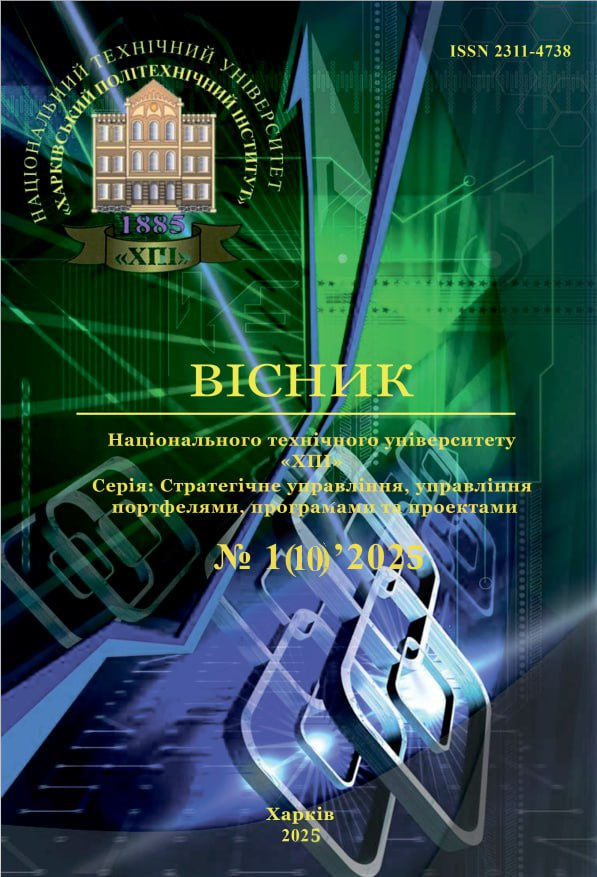GOAL-SETTING MODEL FOR DEVELOPMENT PROJECTS IN THE MARITIME INDUSTRY
DOI:
https://doi.org/10.20998/2413-3000.2025.10.7Keywords:
goal setting, strategic management, resource optimization, risk management, coalition function, critical path method, dynamic development model, dynamic optimisationAbstract
A comprehensive 5C goal-setting model is proposed as a tool for strategic project management in developing maritime industry enterprises. The model includes five key stages: Context, Concept, Collaboration, Construction, and Continuity, ensuring a systematic approach to project management. The proposed model is based on the application of modern mathematical methods and algorithms, including the risk function, which enables a quantitative assessment of potential threats, the integral function of market conditions for evaluating changes in the competitive environment, and resource optimisation methods, which minimise costs and ensure their efficient allocation. Special attention is given to the coalition function, which determines the effectiveness of interaction between project participants, and the Shapley value method, which ensures a fair distribution of benefits among partners. The critical path method is implemented to optimise the task execution schedule. At the same time, the dynamic development model allows for an assessment of the project's long-term stability in a changing market environment. A dynamic optimisation mechanism is proposed to facilitate the continuous improvement of management processes and the adoption of well-founded strategic decisions. The obtained results confirm the effectiveness of the proposed model for development projects in the maritime industry, especially under conditions of high dynamism and uncertainty. The practical application of the model enhances enterprise competitiveness, minimises risks, ensures balanced development, and integrates the principles of environmental, social, and corporate governance into management processes. In the future, the 5C model can be adapted to other sectors of the economy that require a systematic approach to strategic project management.
References
Bushuyev S., Bushuiev D., Bushuieva V., Bushuyeva N., Tykchonovych J. Strategic project management development under influence of artificial intelligence. Вісник Національного технічного університету «ХПІ». Серія: Стратегічне управління, управління портфелями, програмами та проектами. 2024. № 1(8). P. 3–7. doi: https://doi.org/10.20998/2413-3000.2024.8.1 URL: http://pm.khpi.edu.ua/issue/view/18146. (дата звертання: 9 січня 2025).
Wang J., Sii H. S., Yang J. B., Pillay A., Yu D., Liu J., Maistralis E., Saajedi A. Use of advances in technology for maritime risk assessment. Risk Analysis. 2004. Vol. 24(4). P. 1041–1063. doi: https://doi.org/10.1111/j.0272-4332.2004.00506.x
Hjellvik S., Mallam S. Integrating motivated goal achievement in maritime simulator training. WMU Journal of Maritime Affairs. 2023. Vol. 22. P. 209–240. doi: https://doi.org/10.1007/s13437-023-00309-2
Sharma A., Nazir S., Ernstsen J. Situation awareness information requirements for maritime navigation: A goal-directed task analysis. Safety Science. 2019. Vol. 120. P. 745–752. doi: https://doi.org/10.1016/j.ssci.2019.08.016
Wang P., Mileski J. P. Strategic maritime management as a new emerging field in naval studies. Maritime Business Review. 2018. Vol. 3. P. 1–31 doi: https://doi.org/10.1108/MABR-06-2018-0019
Ковтун T., Ковтун Д. Характеристика проєктів екологістичних систем. Вісник Національного технічного університету «ХПІ». Серія: Стратегічне управління, управління портфелями, програмами та проектами. 2022. №. 2(6). С. 45–52. doi: https://doi.org/10.20998/2413-3000.2022.6.9. URL: http://pm.khpi.edu.ua/article/view/262373. (дата звертання: 11 січня 2025).
Ковтун T. Визначення ролі екологізації в досягненні цілей сталого розвитку. Розвиток методів управління та господарювання на транспорті. 2020. №. 2(71). P. 63–81.
Олех Т.М., Руденко С.В., Гогунський В.Д. Оцінка ефективності екологічних проєктів. Східно-Європейський журнал передових технологій. 2013. № 1(10/61). С. 79–82.
Cariou P., Ferrari C., Parola F. Strategies in maritime and port logistics. Maritime Economics & Logistics. 2015. Vol. 17(1). P. 1–8.
Dinwoodie J., Tuck S., Knowles H., Benhin J., Sansom M. Sustainable development of port maritime operations. Business Strategy and the Environment. 2012. Vol. 21(2). P. 111–126.
Shakhov A., Kyryllova O., Sagaydak O., Piterska V., Sherstiuk O. Conceptual risk-oriented model of goal setting in the implementation of concession projects in seaports. CEUR Workshop Proceedings. 2022. Vol. 3295. P. 149–158.
Parola F., Satta G., Panayides P. M. Corporate strategies and profitability of maritime logistics firms. Maritime Economics & Logistics. 2015. Vol. 17(1). P. 52–78.
Lee E. S., Song D. W. Knowledge management for maritime logistics value: discussing conceptual issues. Maritime Policy & Management. 2010. Vol. 37(6). P. 563–583.
Hollen R., Van Den Bosch F. A., Volberda H. W. The role of management innovation in enabling technological process innovation: An inter-organizational perspective. European Management Review. 2013. Vol. 10(1). P. 35–50.
Jenssen J. I., Randy T. The performance effect of innovation in shipping companies. Maritime Policy & Management. 2006. Vol. 33(4). P. 327–343.
Downloads
Published
Issue
Section
License

This work is licensed under a Creative Commons Attribution-NonCommercial-ShareAlike 4.0 International License.
Our journal abides by the Creative Commons copyright rights and permissions for open access journals.
Authors who publish with this journal agree to the following terms:
Authors hold the copyright without restrictions and grant the journal right of first publication with the work simultaneously licensed under a Creative Commons Attribution-NonCommercial-ShareAlike 4.0 International License (CC BY-NC-SA 4.0) that allows others to share the work with an acknowledgement of the work's authorship and initial publication in this journal.
Authors are able to enter into separate, additional contractual arrangements for the non-commercial and non-exclusive distribution of the journal's published version of the work (e.g., post it to an institutional repository or publish it in a book), with an acknowledgement of its initial publication in this journal.
Authors are permitted and encouraged to post their published work online (e.g., in institutional repositories or on their website) as it can lead to productive exchanges, as well as earlier and greater citation of published work.

